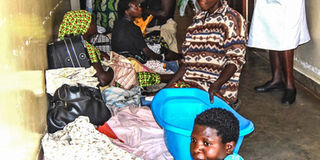Expectant mothers shun health facilities for TBAs

Expectant mothers wait in the corridors of a maternity ward at Fort Portal Regional Referral Hospital where some women from Ntoroko District are referred to for better treatment. PHOTO BY SCOVIA ATUHAIRE
Ntoroko- Desperate expectant women in Ntoroko District trek long distances to access public health facilities.
Because they are vulnerable, a significant number have now opted to deliver at the hands of traditional birth attendants (TBAs) whose services were outlawed in 2010.
TBAs are individuals who use old-fashioned tools, skills and knowledge to help women to give birth.
The government outlawed TBAs nine years ago with a view to improve maternal mortality since some women were dying at the hands of TBAS.
Government argued that seeking services from TBAs, women risk their lives since there are high chances of contracting infections from tools used during delivery and incase of complications where they need referrals.
Effects
Such cases include over bleeding and other complications that may arise during delivery.
Despite the government ban, TBAs have continued to operate in many rural areas, Ntoroko district inclusive.
Expectant women in hard-to-reach areas are left with no option but to seek services of TBAs.
Ms Masika Doreen, 39, a resident of Kanara Sub-county is hindered by the long distance and topography of the area, especially during rainy season where most parts of the district experience flooding that blocks roads.
From her sub-county, there is a distance of more than 20 kilometres to access Karungutu Health Centre IV.
“We continue to deliver from our villages with the help of traditional birth attendant, which is risky. I was helped by my fellow mothers to deliver all my four children,” she says.
Masika’s narrative is similar to that of Ms Jane Muhindo from Butugama Sub-county, a mother of five children, four of whom were delivered with the help of TBAs.
“If you don’t have money to hire a car, it becomes difficult. We, therefore, miss out on antenatal care (ANC) visits, which are a must for every pregnant mother” Ms Jane Muhindo says.
Long distance
Expectant women hailing from Kanara Sub-county move 35 kilometres to seek services from Rwebisengo Town Council while residents of Butugama Sub-county trek 15 kilometres to access Rwebisengo Health Centre.
Ms Harriet Kabakama from Rwebisengo Town Council says although she stays near to the health facility, it is overwhelmed by the patients’ turn out.
Ms Jessica Bahati, a member of the village health team in Kanara Town Council, the only nearby health centre III is always overwhelmed by patients who come from the Democratic Republic of Congo (DRC) passing through Kanara Landing Site while others come from Kibaale landing site.
“I was a traditional birth attendant but was advised to refer pregnant mothers to the health facilities which I do but I’m approached by desperate mothers,” Ms Bahati says.
The senior public relations officer at the Ministry of Health, Mr Emmanuel Ainebyoona, says his ministry discourages expectant women from seeking any medical help from traditional birth attendants.
“We completely discourage mothers from going to traditional birth attendants because they are not professionally trained to handle medical matters. We encourage mothers to access antenatal services from trained medical officials at least eight times during their pregnancy cycle” Mr Ainebyoona says.
District speaks out
The Ntoroko District Health Officer, Dr Rogers Mugisha, admits that the district still registers few pregnant women who come to deliver in the public health facilities.
“I cannot say all mothers in our district deliver from health facilities in the district because we still have mothers who deliver with the help of traditional birth attendants,” Dr Mugisha says.
The Ntoroko District chairperson, Mr Timothy Kyamanywa, explains that some sub-counties and town councils do not have health facilities. He cites Kanara, Rwebisengo, Kibuuku and Butugama as cases in point.
“As a district, we have no capacity to construct health facility and also to recruit health workers and pay their salaries. We have written many letters to Ministry of Health but up to now there is no response,” Mr Kyamanywa says.
What govt is doing to address the issue
The National Population and Housing Census Report, 2014, indicates that households that are five kilometres or more to the nearest public health facility were at 43 per cent in Ntoroko District.
The district, that became operational in 2010 after being carved out Bundibugyo District, currently has six public health facilities and other three private facilities.
The six public health facilities include three health centre III, two health centre II and one health centre.
Ministry of Health report for June 2017 to June 2018 indicates that the delivery rate in health facilities in Ntoroko District is at 56 per cent.
Due to shortage of public health facilities, few mothers attend antenatal care services from first visit to fourth visit.
The district performance report for June 2017 to June 2018 shows that pregnant women who attended the antenatal care services fourth visit were 51.6 per cent.
Ntoroko District has six sub-counties and four town councils but only three town councils have health centre III and out of 49 parishes, 42 do not have any health facility.
As government policy, every sub-county should have health centre III and a health centre II for each parish level and the district is supposed to have a general hospital.
However, some mothers in Ntoroko District are referred to Fort Portal Regional Referral Hospital which is 78 kilometres away.
The expectant women have to travel by road for about one and a half hours in an ambulance, a taxi or a hired car for those who can afford the cost in order to access a referral hospital. Some referred women arrive at the facility when their conditions have degenerated due to delays in accessing medical care.
The senior public relations officer at the Ministry of Health, Mr Emmanuel Ainebyoona, says government is already addressing the bottlenecks of access to health facilities.
“Under the Inter-Governmental Fiscal Transfer Programme, we are constructing a health centre III in each sub-county. So far, more than 120 health centres are under construction across the country” he says.
“Just like other areas with long distances to health facilities, Ntoroko District will benefit from this programme,” he adds.
“We intend to reduce a distance to the nearest health centre to at least five kilometres,” he says.




